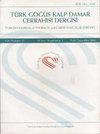Factors affecting survival after anatomical lung resection in pulmonary aspergilloma: Our 10-year single institution experience
IF 0.5
4区 医学
Q4 SURGERY
Turk Gogus Kalp Damar Cerrahisi Dergisi-Turkish Journal of Thoracic and Cardiovascular Surgery
Pub Date : 2022-01-01
DOI:10.5606/tgkdc.dergisi.2022.19982
引用次数: 0
Abstract
Background The aim of this study was to investigate the long-term outcomes of patients who underwent anatomic lung resection for pulmonary aspergilloma and to evaluate the prognostic factors affecting early postoperative morbidity. Methods Between January 2007 and January 2017, we retrospectively evaluated a total of 55 patients (40 males, 15 females; mean age: 44.6 years; range, 18 to 75 years) who underwent lobectomy and pneumonectomy for pulmonary aspergilloma. All patients were evaluated for simple or complex aspergilloma based on imaging and thoracotomy findings. Results Thirty-two (58.2%) patients presented with hemoptysis. Seven (12.7%) patients underwent emergency surgery due to massive hemoptysis. Postoperative morbidity was observed in 15 (27.3%) patients. Prognostic factors that had an effect on morbidity were resection type, Charlson Comorbidity Index >3, and massive hemoptysis (p<0.05). There was no intra- or postoperative mortality. The five-year survival rate was 89.4%. None of the factors evaluated in the study were associated with survival. Conclusion The main finding of this study is the absence of mortality after surgical treatment for pulmonary aspergilloma. The success of surgical treatment depends on the management of postoperative complications.影响肺曲菌瘤解剖性肺切除术后存活的因素:我们10年的单一机构经验
本研究的目的是探讨解剖肺切除肺曲菌瘤患者的长期预后,并评估影响术后早期发病率的预后因素。方法2007年1月至2017年1月,我们回顾性评估了55例患者(男性40例,女性15例;平均年龄:44.6岁;范围:18 - 75岁),因肺曲菌瘤而行肺叶切除术和全肺切除术。所有患者均根据影像学和开胸检查结果评估单纯曲菌瘤或复杂曲菌瘤。结果32例(58.2%)患者出现咯血。7例(12.7%)患者因大咯血接受紧急手术。术后发病15例(27.3%)。影响发病率的预后因素为切除类型、Charlson合病指数>.3、大咯血(p<0.05)。无术中或术后死亡。5年生存率为89.4%。研究中评估的所有因素都与生存率无关。结论肺曲菌瘤手术治疗后无死亡率,是本研究的主要发现。手术治疗的成功与否取决于术后并发症的处理。
本文章由计算机程序翻译,如有差异,请以英文原文为准。
求助全文
约1分钟内获得全文
求助全文
来源期刊

CiteScore
1.00
自引率
0.00%
发文量
98
审稿时长
3-8 weeks
期刊介绍:
The Turkish Journal of Thoracic and Cardiovascular Surgery is an international open access journal which publishes original articles on topics in generality of Cardiac, Thoracic, Arterial, Venous, Lymphatic Disorders and their managements. These encompass all relevant clinical, surgical and experimental studies, editorials, current and collective reviews, technical know-how papers, case reports, interesting images, How to Do It papers, correspondences, and commentaries.
 求助内容:
求助内容: 应助结果提醒方式:
应助结果提醒方式:


